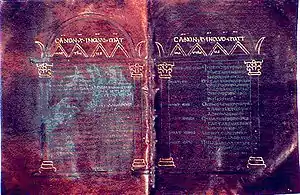Codex Brixianus
The Codex Brixianus (Brescia, Biblioteca Civica Queriniana, s.n.), designated by f, is a 6th-century Latin Gospel Book which was probably produced in Italy.

Description
The manuscript contains 419 folios. The text, written on purple dyed vellum in silver ink, is a version of the old Latin translation which seems to have been a source for the Gothic translation of Ulfilas. At the base of each page is an arcade very similar to that found in the Codex Argenteus. Furthermore, the Latin text shows readings which seem to be influenced by the Gothic Bible translation.
Text
It has some lacunae (Matthew 8:16–26; Mark 12:5–13:32; 14:53–62; 14:70–16:20).[1][2]
It was named Brixianus after Brescia in Italy, where it is housed.
In Luke 7:31, it contains the phrase "tunc ergo iesus dixit".[3]
References
- Scrivener, Frederick Henry Ambrose; E. Miller (1894). A Plain Introduction to the Criticism of the New Testament. 2. London. p. 46.
- C.R. Gregory (1902). Textkritik des Neuen Testamentes. II. Leipzig: J.C. Hinrichs. p. 603.
- White, Henry Julian; Wordsworth, John; Sparks, Hedley Frederick Davis (1889). Nouum Testamentum Domini nostri Jesu Christi latine, secundum editionem Sancti Hieronymi. Robarts - University of Toronto. Oxonii, Clarendon.
Further reading
- F. C. Burkitt (1900). "The Vulgate Gospels and the Codex Brixianus". JTS: 129–134.